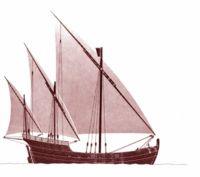Caravel
The Caravel was the “work-horse” of the Spanish and Portuguese during the Age of Exploration; a vessel that would be adapted according to the varying needs and challenges of the era.
In the early 15th century a caravel was termed as a Portuguese two-masted lateen rigged carvel-built vessel with forecastle and deckhouse, designed for trade in the Mediterranean and the Atlantic coast. When Henry the Navigator began his search for a sea route to India in the 1420s one of his priorities was the development of a suitable vessel. The caravela Latina was the first design change, with a slimmer hull and three masts, though still all lateen rigged. This was followed by the caravella redonda, a three masted vessel, square-rigged on the fore- and mainmast, however the mizzen retained the lateen sail as an aid to manoeuvrability. By the 16th century four-masted versions had appeared. A watercolor by the sixteenth century Spaniard, Monleon, shows two four-masted caravels square-rigged on only the foremast. During the fifteenth century, the use of topsails was developed.
Their size varied. Bartholomew Diaz sailed with two small caravels designed for poking about amongst the shoals and reefs of an unknown coast. Vasco da Gama, on the advice of Diaz, was supplied with much larger and heavily armed caravels. Columbus’ Niña and Pinta were small caravels. (Santa Maria was a “Nao”, a much larger and older design, developed from the craft that had carried the Crusaders two centuries and more before.) Magellan’s fleet included large four-masted caravels.
The term refers to the type of hull. The hulls of caravels were a mixture of Iberian and Arab design and were carvel built. That is, the strakes, or planks, of the hull were butt jointed along their edges; not overlapping (clinker built). This meant less drag, easier cleaning and enabled the use of shorter boards and the construction of a double hull if required. This method was not new – its use has been recorded from ancient times – but the success of the caravel caused an explosion in its use, and large carvel built vessels were being built in Holland and the Baltic by the second half of the fifteenth century. The word caravel, however, usually refers to those vessels of the Iberian Peninsula.
Glossary
- Forecastle, these days, is the space below the forward deck. It was, in the Middle Ages, indeed up to the development of the galleon, a raised portion of a ship from which archers and (later) musketeers could fire down on the enemy ship. It is pronounced “fo’c’sle".
- Mizzen refers to the aft mast on any vessel with three or more masts. The one at the stern.
- Square-rigged refers to the set of the sails on what most people would consider the classic large sailing ship – the galleon or the clipper for example, or any large warship of the age of sail. The sails are set across the bow to stern line of the vessel and are four-sided and attached to yards that can be angled according wind direction.
- Strakes refer to the longitudinal planks of a wooden vessel that, attached to the ribs from the keel to the top of the sides, make up the hull. A craft can be referred to as being carvel- or clinker-built, depending on the way the strakes are put together.
Sources
"Dictionary of Ship Types", (Conway Maritime Press) J. R. Parry, "The Age of Exploration", (Uni of California Press) Lincoln Paine, "The Sea and Civilization", Atlantic Books, London
